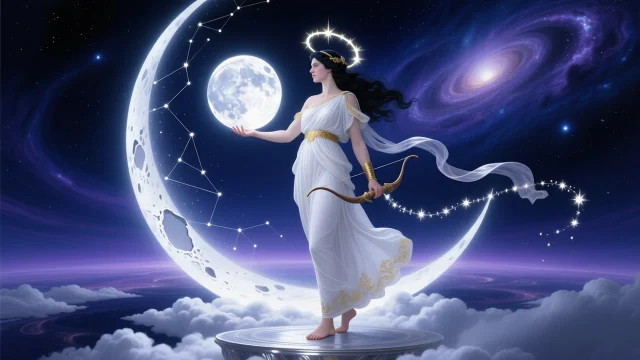Greek mythology is certainly full of many interesting gods, goddesses, mythical creatures, and heroes, each with their own unique stories to amaze us all. Perhaps, as one of the most unique characters in all of Greek mythology, Hecate’s story may be more interesting than others you have heard.
Who was Hecate?

Hecate was the Greek goddess of magic, witchcraft, crossroads, ghosts, necromancy, and knowledge of herbs and poisonous plants. She was also known as the goddess of the moon and the night.
Hecate’s family
Since ancient stories have changed considerably over time, there are more than a few ideas about who Hecate’s parents were. The writings of Greek mythology do not give an exact description of Hecate’s parents, however, these four pairs of beings are said to be them in different sources: Perses and Asteria; Zeus and Demeter; Zeus and Hera; Leto and Tartarus.
While this fact differs from story to story, the rest of the story tends to be fairly consistent across accounts.
Hecate was considered an ancient Thracian deity and was also a Titan; the Titans ruled the heavens, the earth, and the sea. They gave mortals wealth, victory, wisdom, and luck. According to her story, Hecate sometimes withheld these blessings if she felt that mortals did not deserve them.
When the Olympians defeated the Titans, Hecate was the only one allowed to keep her powers under Zeus’ rule. She was honored by all the immortal gods.
Hecate’s abilities
Hecate was considered the goddess of magic, witchcraft, crossroads, portals, ghosts, and necromancy. Over time, people began to consider her one of the following three “triple goddesses”:
- Persephone as the young maiden
- Demeter the mother
- Hecate, the wise woman.
Hecate was a wise goddess and often helped the gods in their wars against the giants.
Hecate and the underworld
Hecate was called the queen and goddess of the night. Accompanied by her hounds, ghosts, and people who were considered social outcasts, she made journeys during the night. Some of these journeys were made to the underworld, sometimes to help other gods according to myths.
The underworld was a land of the dead and the sleeping, a place that would not particularly be a choice for a goddess born in the Greek heavens. Hecate felt comfortable in the underworld . Who did she find there? She found those who were rejected out of fear or misunderstanding. As she was also different from most beings, she enjoyed the company of these unique individuals.
Hecate witnessed the abduction of Persephone. Hecate saw Hades kidnap Persephone to make her his new bride. After this happened, Zeus asked Hecate to go find Persephone.
Hecate found Persephone, but the outcome was not what Zeus wanted. Hecate went to the underworld and helped a frightened Persephone adapt to her new life. Hades appreciated this gesture. To show gratitude for Hecate’s actions, Hades invited her to be a permanent resident of the underworld. Hecate could come and go as she pleased. Hecate’s decision was unique, and in the end, it benefited her.
Hecate as the goddess of crossroads

Hecate was often depicted with three heads. This translates into the belief that she could see in all directions and also into all parts of the timeline: the past, the present, and the future. That is why she was called “the goddess of the crossroads.”
Hecate considered these directions to be converging paths. These crossroads were sacred to her. Because she could see in all directions, she possessed the wisdom that many beings sought. She used her power to determine whether mortals were worthy of blessings.
In ancient times, all crossroads were marked with three masks on a pole. Many people left food such as garlic and cypress near these poles as a way to honor Hecate and feed those who spent the night with her. As you can understand, Hecate’s unique characteristics were not considered evil or frightening. People believed she could use her magic for good.
Hecate as Protector
Thanks to her magical powers, Hecate was considered the protector of young children, shepherds, and sailors. Her believers counted on her to help the dying. It was believed that Hecate facilitated their transitions to the “other world,” as she did with Persephone.
Hecate in Ancient Greece
People often incorporated Hecate and her stories into their daily lives: Homes in ancient Greece admired Hecate and felt honored to help bring prosperity.
Hecate shrines were built in homes and at the entrances of many cities to ask Hecate not to bring any evil spirits into their world. People trusted and prayed that Hecate would keep them in touch with their spiritual side. Today, some of these beliefs are still held by a small number of people.
Hecate in art
Artists have sculpted or painted Hecate in three ways. She was painted holding twin torches with a knee-length skirt and boots. This type of painting symbolizes the event in which she helped Demeter search for Persephone.
Ancient sculptures depict her with three heads to celebrate how she could look in all directions. Some works of art portray her with two other people as part of the “triple goddesses.”
Symbols of Hecate
There are six symbols associated with Hecate:
- The pair of torches
- A key
- Snakes
- Daggers
- Skunk
- Dogs
In most depictions, Hecate is shaped like a dog or accompanied by a dog. They played an important role:
- Used as sacrificial animals
- They helped him dig up the plants he needed for medicine or magic.
Not fitting the usual descriptions made by others, Hecate was surely one of the most interesting goddesses in Greek mythology. I hope you enjoyed the post about Hecate, the Greek goddess of magic, witchcraft, crossroads, and necromancy. Share it if you did!

